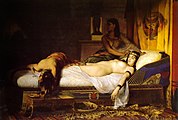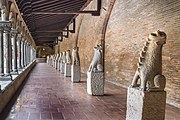Musée des Augustins
Fine arts | |
| Director | Axel Hémery |
|---|---|
| Website | http://www.augustins.org/en/ |
The Musée des Augustins de Toulouse is a fine arts museum in
History

The building in which the museum is sited was built in 1309, in the
The Musée des Augustins de Toulouse was one of fifteen museums founded in provincial centres, by a decree of 13
Collections

The progressive concern of the museum's founder Jean-Antoine Chaptal, an early example of cultural devolution, was intended to ensure that "each collection presents an interesting series of paintings representing all the masters, all the genres and all the schools". In a series of shipments culminating in 1811, Toulouse was enriched with works by Guercino, Pietro Perugino, Rubens and Philippe de Champaigne.
The collections total over 4,000 works and their core derives from confiscation of Church property at the time of the French Revolution as well as seizures of the private collections of émigrés, in Toulouse notably the paintings of the cardinal de Bernis and Louis-Auguste le Tonnelier, baron de Breteuil. The museum's church even houses an organ built in 1981 by Jürgen Ahrend when Denis Milhau[5][circular reference] was director of the musée between 1963 and 1994.
Paintings
The French schools of the 15th to 18th centuries are represented by
-
Gabriel Guay, La dernière dryade (1898).
-
Perugino, Saint John the Evangelist and Saint Augustine (1512-1523).
-
Jean-André Rixens, Death of Cleopatra (1874).
-
Édouard Debat-Ponsan, The massage
-
Nicolas Tournier, Descent from the Cross
-
Joseph Roques, Portrait of Madame Sermet
Sculpture
The museum's sculpture collection is in large part due to the rescue activities of antiquaries and museum curators such as Alexandre du Mège who managed to extricate sculpture from the frequent destruction of religious buildings that marked the 19th century. It is particularly strong in 12th-century Romanesque sculpture from the city's three main religious buildings - the priory of
-
Salvagedgargoylesdisplayed in the cloister
-
Hall of Romanesque capitals
-
Sculptures by the Master of Rieux - In the foreground, Jean Tissendier, bishop of Rieux
-
Saint Paul by the Master of Rieux, 1333-1343
-
Nostre Dame de Grasse (1460-1500)
-
Lady Tholose, 1544-1550
See also
- Listing of the works of Alexandre Falguière
References
- ^ Chalande, Jules (1921), "Histoire des rues de Toulouse: 230- Le musée des Augustins", Mémoires de l'Académie des sciences, inscriptions et belles-lettres de Toulouse, 9 (11): 143
- Jacques-Paul Migneéditeur. 1855. p. col. 1301.
- ISBN 2-7089-5811-9
- ^ Base Mérimée: PA00094510, Ministère français de la Culture. (in French)
- ^ fr:Denis Milhau












